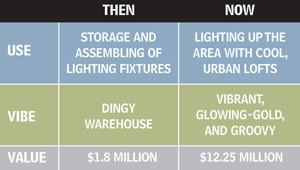Rogowski and Walsh chose a sleek, modern aesthetic for the interiors. With so many other loft conversions going on around the G.W. Lofts, Rogowski says, “We were competing for some sort of identity. We decided we were going to invest in the bathrooms and kitchens so they’d stand out.” Kitchens feature sleek granite countertops, stainless steel appliances, and cabinets with translucent-paneled doors that hinge upward instead of sideways.
Meanwhile, the original floors, ceilings, and exterior walls remain intact, unfinished and rough. “The clash between the old and historic and the new and modern turns out to be absolutely spectacular,” Rogowski says.
Most units include large wood or concrete columns and enormous windows up to 15 feet wide and 7 feet tall. Half of the units have balconies, and four units, located where one building in the complex abuts another, feature terraces built on the lower building’s roof. In the back of the complex, a garden with barbecue grills and bocce ball courts is open to residents.
A GOLD MINE
After construction wrapped up in June of 2008, Walsh reports “a remarkably successful lease-up. All 60 units were leased in 58 days,” he says. Residents include professionals and students from St. Louis University, which is within walking distance.
Back when it was white and nondescript, most people passed by the Guth building without giving it a second glance. Now, that’s changed. Today, the gleaming gold G.W. Lofts has become a symbol of the transformation of the St. Louis Loft District from hum-drum and industrial to vivid and urban.
ELIZABETH LUNDAY is a freelance writer based in Fort Worth, Texas.
Historic Hang-ups
Worried about your renovation project? These three tips may help you dig out of that hole.
- LOOK FOR THE HIDDEN TREASURES. Walking through the old Guth Complex buildings was a depressing exercise—it was dusty, dingy, and dark. Yet a little investigation revealed the stunning gold brick underneath the exterior’s white paint. The lesson: You never know what gift historic buildings are going to give you.
- THINK OLD-SCHOOL. It’s rare to find the original plans for historic buildings, so you won’t always know what you’re dealing with. The solution is to put yourself in the mind of an architect 100 years ago, says project architect Gary Rogowski, AIA, LEED AP. “You have to consider what it was like [and] what methods and means of construction were available then. Try to understand the history, not just of the building, but of the people constructing it,” Rogowski says.
- CHOOSE WAREHOUSES, NOT OFFICES. One advantage of renovating warehouses instead of offices is the freedom of determining how to use your space—particularly when you’re dealing with historic tax credits and the requirements of the National Park Service, says Nat Walsh, developer and founder of St. Louis-based McGowan & Walsh Historic Renovators. The Park Service wants offices to retain a sense of their former floor plan, which restricts how you can lay out units. Warehouses have no such constraint.
